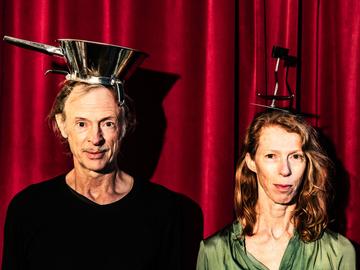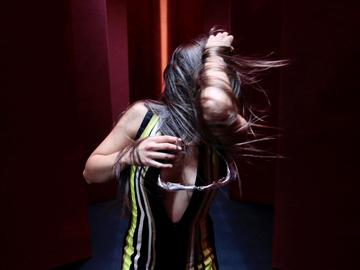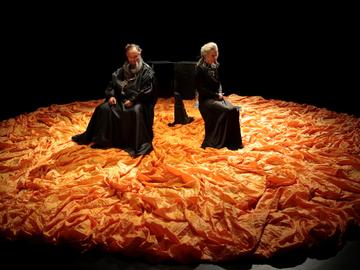Every month, we sniff around the home of a Brussels artist in search of objects with a story. Choreographer Wim Vandekeybus, whose Scattered Memories at KVS compiles 35 years of Ultima Vez, swung his door open for us in Sint-Gillis/Saint-Gilles.
© Sophie Soukias
| Wim Vandekeybus attacked by his twenty-year-old creeper: “I like seeing nature take over.”
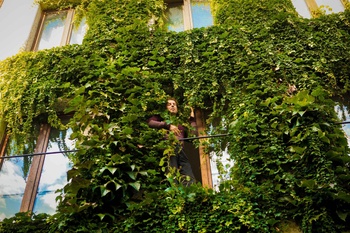
© Sophie Soukias
The creeper
“When I bought this house about twenty years ago, I planted this creeper, and it soon covered pretty much the entire façade. It literally creeps up on you. At the beginning of the year, it’s just a thin stick and you have no idea what will grow out of it. I have to prune it three times a year, or it would start to cover the neighbours’ houses too. Sometimes I am away for a while and then the whole façade is overgrown with huge leaves at the bottom and leaves covering all the windows making it dark inside. There are climbing plants that do not suck onto the wall such as golden chain or wisteria, but I like seeing nature take over with an almost destructive force.”
“It’s a bit of a love-hate relationship, though. In autumn, the street is full of leaves, which I then have to gather and the dogs also like to do their business here. But it’s about the only greenery in the street, so fair enough I suppose! It is also home to pigeons, bees and other insects. It lets you see the seasons change and it’s great when the light shines through the curtains with the shadows of the plant as a background.”
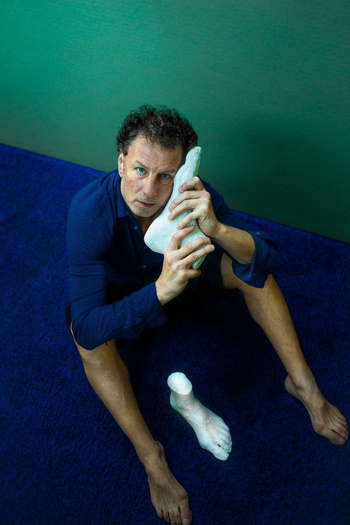
© Sophie Soukias
The plaster cast of his feet
“My feet are certainly an important work tool. This plaster cast was originally made for the 2002 performance ’s Nachts, directed by Nicola Schössler. That included a plaster version of my head, but that has disappeared. Someone must have taken it.”
“I walk around barefoot about half the time. I did recently walking down the street too, which did make people look. I certainly do it in the studio. When it’s cold, we sometimes wear socks, but I don’t like dancers who dance with socks. They mean you slide better, of course, but my movements have more grip and impact.”
“As a choreographer, when casting, you look at how someone places their feet on the ground, because our work involves a lot of walking and groundwork. You have dancers with very powerful feet and dancers with less powerful feet. In the past, in particular, there were dancers with a ballet background whose feet had already been through a lot. Then there are those who can use their feet almost as hands and hug bodies with them.”
“Myself, I have fairly large feet, size 46, with a high instep so I can land with spring. Sort of the opposite of flat feet. Some people quickly get cracks in their feet because they have dry skin. Minor burns from friction on the floor can also be annoying. But overall, I don’t have many injuries. Although I did suffer from heel spur for a while because of stamping. I also need to do some back exercises but mainly it is the knees that suffer from wear and tear. I have had surgery on them too. But I will soon be on stage in Scattered Memories and in Hands Do Not Touch Your Precious Me I even lift Lieve Meeussen and Olivier de Sagazan.
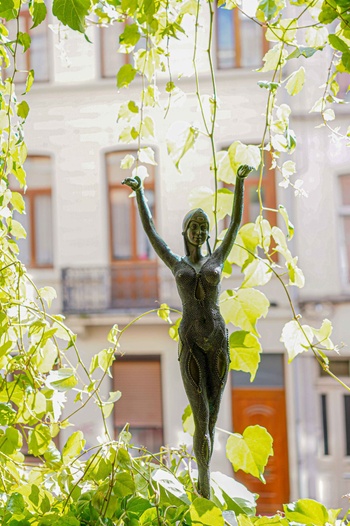
© Sophie Soukias
The bronze statue of Salome
“I am not an art collector but I once bought this sculpture at the flea market, probably seriously underpriced. I used to have two of them, but one I gave away to someone who had worked with us for a long time. I recently found out that it dates from 1925. It is a bronze dancer by the Romanian-Parisian art deco sculptor Demetre Chiparus. It shows Salome, Herod’s daughter during her ‘dance of the seven veils’. Salome has frequently been depicted but I love how graceful this sculpture is. That attitude, that back, very inspiring. Completely not like Ultima Vez and yet, when I recently envisioned the images of the deer we play in Traces, with arms and fingers like antlers, I still saw this image in there.”
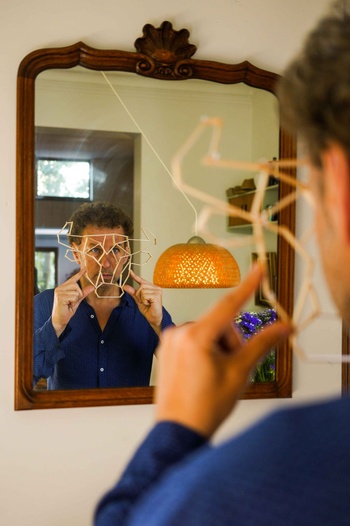
© Sophie Soukias
Bull’s head made of sticks
“When he was nine or ten, my son Iago came home from school with this bull’s head made of wooden sticks that he had made at school and he gave it to me. He had done some googling first and came up with this. A beautiful design and very well done. With the little imperfections that are part of it. It is an image of an animal, but also an abstraction of an animal, and a lot in my work is about transformation into animals. That transformation, that stepping into something you are not and searching for the animal within is actually the dancing.”
“Iago is athletic rather than artistic, but he often dances with us. Sometimes he joins the scene and he is killed by a bear in Traces. His first time on stage was in Sweden playing Oedipus, with lyrics by Jan Decorte, when he was just 18 days old. That was a big deal back then. I desperately wanted a real baby on stage because they can trigger incredible emotions, but that was not allowed almost anywhere. In France I was not even allowed to ask the theatre, in Vienna they reported me and at the KVS, they arrested me and I had to sign a document stating that I would never again use children in my work. In the end, I wrote a letter to the judge explaining how important I felt it was to be able to work with children and young people because they are just more powerful on a stage than us middle-aged people. Sometimes children can do impulse things that you can’t control and which they didn’t learn from anyone. I would have been prepared to go to prison as a way of making a statement about that. But the judge replied that I was allowed to have a child play in that play, but he asked me to follow the law next time.”
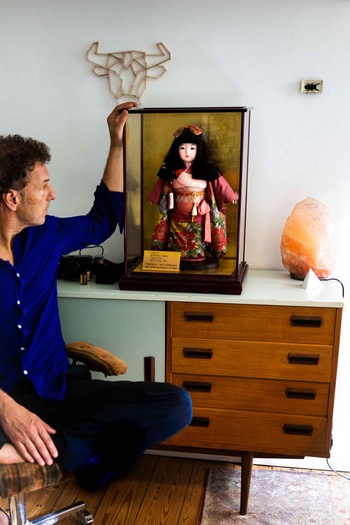
© Sophie Soukias
| SELECT NOV alles uit de kast 4 Wim Vandekeybus
The Japanese doll
“I got this little doll in traditional costume at the 1992 Tokyo International Theatre Festival. During a giant party in Tokyo with the mayor, several of these dolls were given to writers and other artists. I was 29 at the time. The doll spent a long time in the basement after Ultima Vez moved, but we have put it back now. She is probably worth a lot of money. Hence the bell jar and the fact that it was well wrapped when we brought it back from Japan. There is a serenity, a sort of peacefulness and mysticism emanating from it that belongs to a tradition we don’t really understand. Some things you get tired of, but not this doll. She is so well made that it looks almost as if she is alive. It is an image that is eternal. That’s what they said when they gave it to me: ‘This is forever.’”
“Recognition is not insignificant, but I am especially happy that after those early successes with the two Bessie Awards I won in the beginning, we actually never went away with Ultima Vez but instead always have kept making new stuff. I have outlived a lot of organisers and intendants and so I often know the theatres and their technicians longer than the directors running them now. Ultima Vez has over the years given birth to many careers and even literal children have come out of it. It is worth thinking about how to preserve and pass on all that work, which for dance is not something tangible.”
Read more about: Podium , Alles uit de kast , Wim Vandekeybus , the stuff of life

